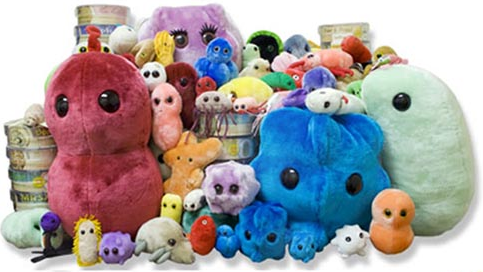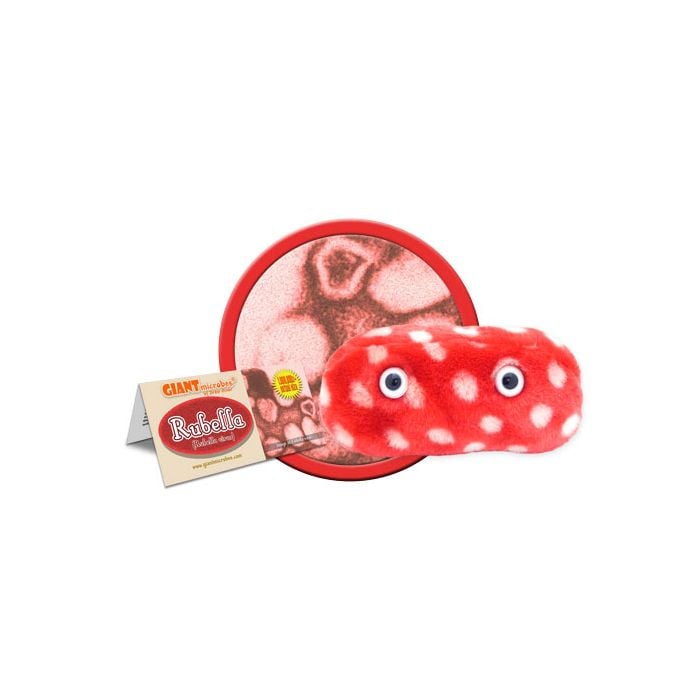Rubella (Rubella virus)
Out of Stock
Product Details
Additional Information
| Sizes | Giantmicrobes are based on actual microbes, cells, organisms and other critters, only 1,000,000 times actual size! Gigantic (GG) 16-24" XL (XL) 10-15" Original (PD) 5-8" Keychain (KC) 2-4" with clip |
|---|---|
| Materials | Plush from all new materials. Stuffed with polyester fiber fill. Surface washable: sponge with water & soap, air dry. |
| Packaging | Each plush microbe includes a printed card with fun, educational and fascinating facts about the actual microbe or cell. |
| Safety | Every product meets or exceeds U.S. and European standards for safety. For ages 3 and up. |
All about Rubella (Rubella virus)
FACTS: A childhood encounter with “little red” (or “rubella” in Latin) was historically considered a rite of passage. Usually symptoms were limited to little red rashes on the face, arms, and torso, often accompanied by joint pains, headaches and fevers, generally lasting no more than three days. In fact, rubella is sometimes referred to as the “three day measles” though this is a colloquialism: true measles is actually caused by Rubeola, which is a completely different virus. (Rubella is also sometimes called “German measles” because the virus was first identified by German doctors in the 1880s.)
Unfortunately, while rubella normally poses only minor risks to healthy individuals, it can be very dangerous to unborn children infected in the womb. If rubella is contracted in the first 20 weeks of life, a rash of devastating consequences can occur including heart disorders, mental retardation, deafness, blindness – and even death.
However, the good news is that since 1969 a vaccine has been available which can provide protection against little red rubella. While children who get the vaccine may already be out of the woods with respect to the most dangerous phase of rubella infection, the protection conferred by the vaccine still spares them the unpleasant encounter – and of course, as community-wide infections are reduced, exposure to the virus in general is naturally more limited.
But most importantly, because the vaccine generally provides long-term immunity against infection, unborn children yet-to-be-conceived are protected as well.
All of which gives the story of little red rubella a very happy ending.
| Name | The name comes from the Latin root word, meaning “little red” to describe the red rash it causes on kids. |
|---|
| Actual Size | 30 to 35 nanometers – that’s 3 million times smaller than a smart phone! |
|---|
| Where It Lives | Rubella is a highly contagious disease caused by a virus. It spreads from person to person through coughing and sneezing. It’s sometimes known as German measles, but don’t let the name and common symptoms confuse you. It’s not the same as measles! |
|---|
| Symptoms | Causes fever and rash that lasts for 2 or 3 days. Kids can sometimes experience swollen glands and aching joints. Women who catch it during pregnancy can pass it to their babies and cause birth defects or miscarriages. |
|---|
| Cure | There is no cure, but the Measles Mumps Rubella, or MMR, vaccine is recommended to prevent the spread of all three diseases. |
|---|
| History |
The disease was first discovered in 1938 by Japanese scientists, Hiro and Tosaka. The virus wasn’t identified until 1962 by Parkman and Weller. Big Outbreaks: 1964: 12.5 million cases of rubella spread across the U.S. and resulting in tens of thousands of birth defects. |
|---|
| Fascinating Facts | It’s been eliminated in the U.S. since 2004. Globally, rubella cases are still reported in high numbers so the vaccine still plays an important role in prevention. |
|---|





